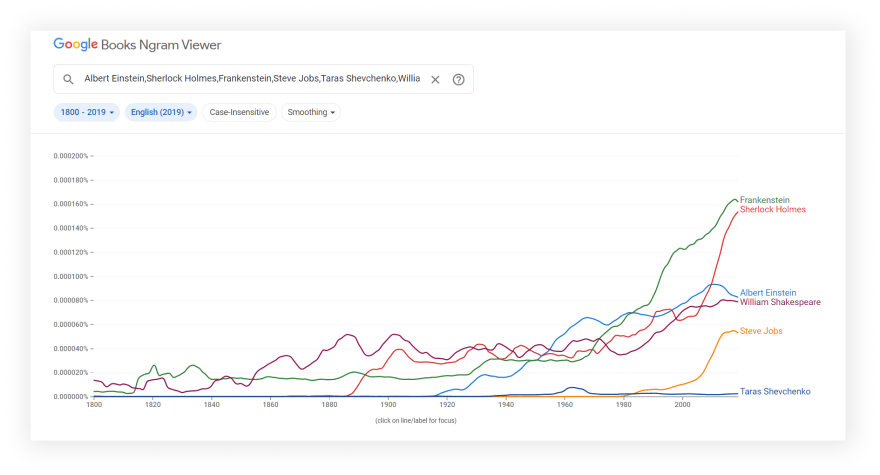Intro
目前,我们没有支持从Google Books ngram Viewer页面中提取数据的API。
这篇博客文章是为了向您展示如何使用下面提供的DIY解决方案自己完成的方式,而我们正在释放适当的API。
该解决方案可用于个人使用,因为它不包括我们为付费的production and above plans提供的Legal US Shield,并且有其限制,例如需要绕过块,例如Captcha。
您可以检查我们的公共路线图以跟踪此API的进度:
将被刮擦
与刮擦数据图进行比较:
完整代码
const axios = require("axios");
const fs = require("fs");
const { ChartJSNodeCanvas } = require("chartjs-node-canvas");
const searchString = "Albert Einstein,Sherlock Holmes,Frankenstein,Steve Jobs,Taras Shevchenko,William Shakespeare"; // what we want to get
const startYear = 1800; // the start year of the search
const endYear = 2019; // the end year of the search
const AXIOS_OPTIONS = {
headers: {
"User-Agent": "Mozilla/5.0 (Windows NT 10.0; Win64; x64) AppleWebKit/537.36 (KHTML, like Gecko) Chrome/101.0.4951.64 Safari/537.36",
}, // adding the User-Agent header as one way to prevent the request from being blocked
params: {
content: searchString, // what we want to search
year_start: startYear, // parameter defines the start year of the search
year_end: endYear, // parameter defines the end year of the search
},
};
async function saveChart(chartData) {
const width = 1920; //chart width in pixels
const height = 1080; //chart height in pixels
const backgroundColour = "white"; // Uses https://www.w3schools.com/tags/canvas_fillstyle.asp
const chartJSNodeCanvas = new ChartJSNodeCanvas({ width, height, backgroundColour });
const labels = new Array(endYear - startYear + 1).fill(startYear).map((el, i) => (el += i));
const configuration = {
type: "line", // for line chart
data: {
labels,
datasets: chartData?.map((el) => {
const data = el.timeseries.map((el) => el * 100);
return {
label: el.ngram,
data,
borderColor: [`rgb(${parseInt(Math.random() * 255)}, ${parseInt(Math.random() * 255)}, ${parseInt(Math.random() * 255)})`],
};
}),
},
options: {
scales: {
y: {
title: {
display: true,
text: "%",
},
},
},
},
};
const base64Image = await chartJSNodeCanvas.renderToDataURL(configuration);
const base64Data = base64Image.replace(/^data:image\/png;base64,/, "");
fs.writeFile("chart.png", base64Data, "base64", function (err) {
if (err) {
console.log(err);
}
});
}
function getChart() {
return axios.get(`https://books.google.com/ngrams/json`, AXIOS_OPTIONS).then(({ data }) => data);
}
getChart().then(saveChart);
准备
首先,我们需要创建一个node.js* project并添加koude0软件包koude1以向网站提出请求,以从接收到的数据和koude3构建图表,以使用koude4。
为此,在我们项目的目录中,打开命令行并输入:
$ npm init -y
,然后:
$ npm i axios chart.js chartjs-node-canvas
*如果您没有安装node.js,则可以download it from nodejs.org并遵循安装documentation。
Process
我们将以JSON格式接收书籍ngram数据,因此我们只需要处理收到的数据,并创建自己的图表(如果需要):
请求:
axios.get(`https://books.google.com/ngrams/json`, AXIOS_OPTIONS).then(({ data }) => data);
响应json:
[
{
"ngram": "Albert Einstein",
"parent": "",
"type": "NGRAM",
"timeseries": [
0, 0, 0, 0, 0, 0, 0, 0, 0, 0, 0, 0, 0, 0, 0, 0, 9.077474010561153e-10, 9.077474010561153e-10, 9.077474010561153e-10,
...and other chart data
]
},
{
"ngram": "Sherlock Holmes",
"parent": "",
"type": "NGRAM",
"timeseries": [
4.731798064483428e-9, 3.785438451586742e-9, 3.154532042988952e-9, 2.7038846082762446e-9, 0, 2.47730296593878e-10,
...and other chart data
]
},
...and other Books Ngram data
]
代码说明
从koude1,koude6声明常数(fs库允许您使用计算机上的文件系统)和koude3库:
const axios = require("axios");
const fs = require("fs");
const { ChartJSNodeCanvas } = require("chartjs-node-canvas");
接下来,我们写我们想要获得的东西,年结束年开始:
const searchString = "Albert Einstein,Sherlock Holmes,Frankenstein,Steve Jobs,Taras Shevchenko,William Shakespeare";
const startYear = 1800;
const endYear = 2019;
接下来,我们编写一个请求选项:用koude10的koude9,用于用作“真实”用户访问,以及用于提出请求的必要参数。
Default koude1 request user-agent is koude12因此,网站了解这是一个发送请求并可能阻止它的脚本。 Check what's your user-agent:
const AXIOS_OPTIONS = {
headers: {
"User-Agent": "Mozilla/5.0 (Windows NT 10.0; Win64; x64) AppleWebKit/537.36 (KHTML, like Gecko) Chrome/101.0.4951.64 Safari/537.36",
}, // adding the User-Agent header as one way to prevent the request from being blocked
params: {
content: searchString, // what we want to search
year_start: startYear, // parameter defines the start year of the search
year_end: endYear, // parameter defines the end year of the search
},
};
接下来,我们编写一个函数,该函数处理并保存收到的数据到“ .png”文件:
async function saveChart(chartData) {
...
}
在此功能中,我们需要声明koude4 width,height和backgroundColor,然后使用koude3构建它:
const width = 1920; //chart width in pixels
const height = 1080; //chart height in pixels
const backgroundColour = "white"; // Uses https://www.w3schools.com/tags/canvas_fillstyle.asp
const chartJSNodeCanvas = new ChartJSNodeCanvas({ width, height, backgroundColour });
然后,我们需要定义并创建“ x”轴标签。为此,我们需要创建一个new array,其长度等于从startYear到endYear的年数(我们添加1',因为我们还需要包括这些年)。
然后,我们koude20带有startYear的数组,然后将元素位置(i)添加到每个值(使用koude23方法):
const labels = new Array(endYear - startYear + 1)
.fill(startYear)
.map((el, i) => (el += i));
接下来,我们需要为koude2库创建configuration对象。在此对象中,我们定义图表type,data和options。
在图表data中,我们定义了主轴labels,并从接收到的chartData中制作datasets,其中我们为每个行标签,数据和随机颜色设置(使用koude33和koude34方法)。
在图表options中,我们设置了'y'轴名称并允许显示(display属性):
const configuration = {
type: "line", // for line chart
data: {
labels,
datasets: chartData?.map((el) => {
const data = el.timeseries.map((el) => el * 100);
return {
label: el.ngram,
data,
borderColor: [`rgb(${parseInt(Math.random() * 255)}, ${parseInt(Math.random() * 255)}, ${parseInt(Math.random() * 255)})`],
};
}),
},
options: {
scales: {
y: {
title: {
display: true,
text: "%",
},
},
},
},
};
接下来,我们等待在koude37编码中构建图表,从base64 String(koude39方法)中删除数据类型属性,然后使用koude40方法保存“ Chart.png”文件:
const base64Image = await chartJSNodeCanvas.renderToDataURL(configuration);
const base64Data = base64Image.replace(/^data:image\/png;base64,/, "");
fs.writeFile("chart.png", base64Data, "base64", function (err) {
if (err) {
console.log(err);
}
});
然后,我们编写一个函数,该函数使请求并返回接收到的数据。我们收到了koude1请求的响应,该请求具有我们destructured的data键,然后返回:
function getChart() {
return axios
.get(`https://books.google.com/ngrams/json`, AXIOS_OPTIONS)
.then(({ data }) => data);
}
最后,我们需要运行我们的功能:
getChart().then(saveChart);
现在我们可以启动我们的解析器:
$ node YOUR_FILE_NAME # YOUR_FILE_NAME is the name of your .js file
保存文件
如果您想查看一些用serpapi制定的项目,write me a message。
添加一个Feature Requestð«或Bugð

